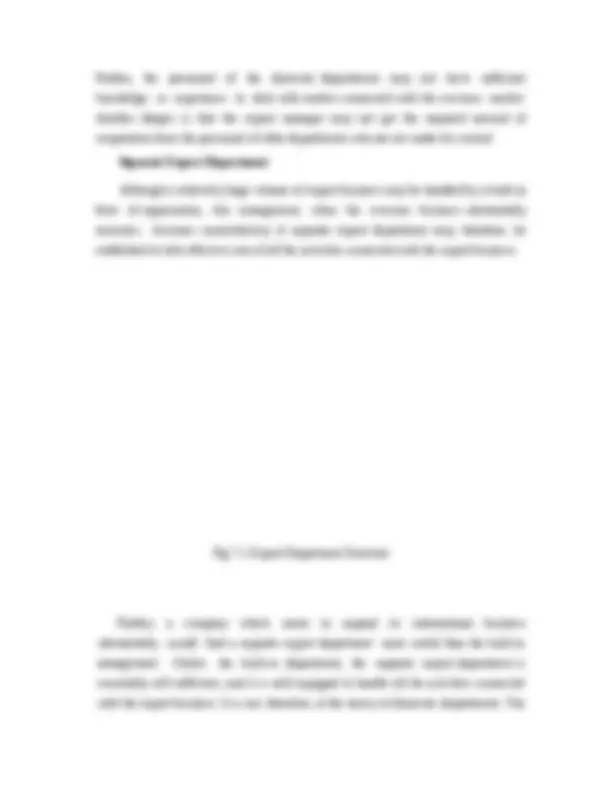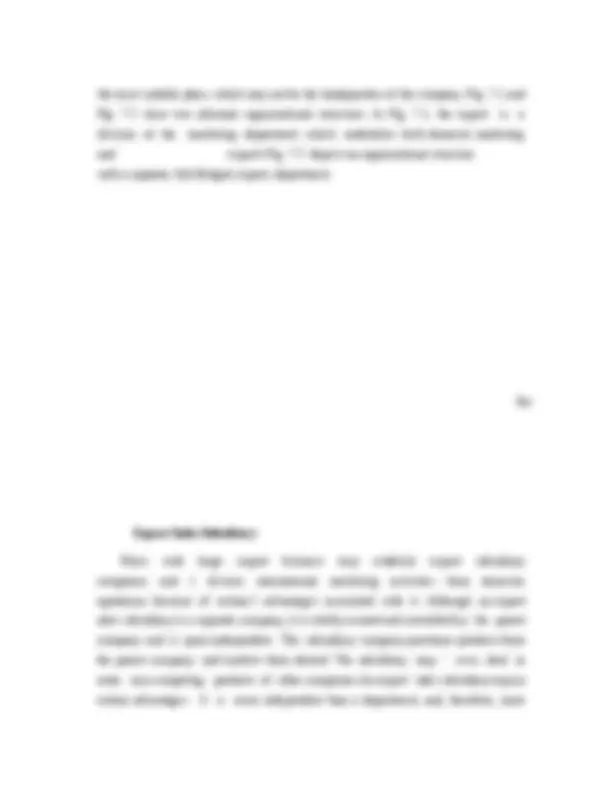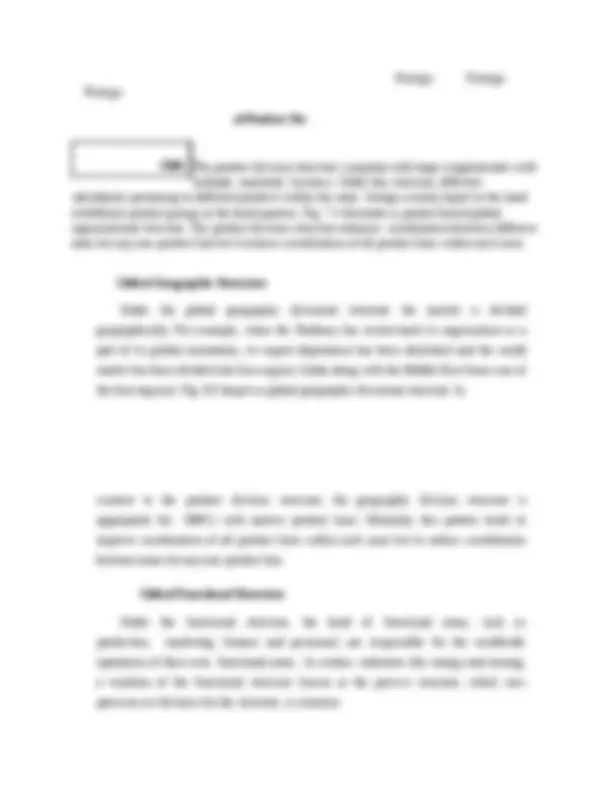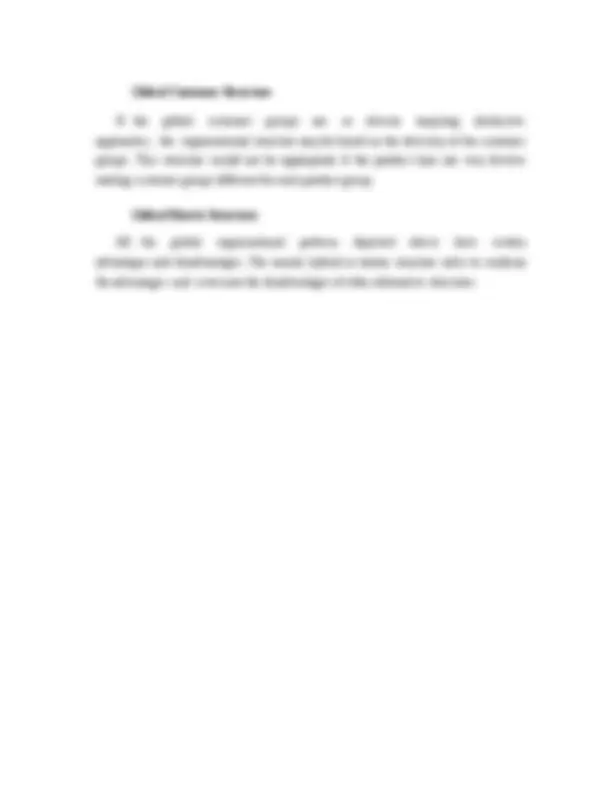








Study with the several resources on Docsity

Earn points by helping other students or get them with a premium plan


Prepare for your exams
Study with the several resources on Docsity

Earn points to download
Earn points by helping other students or get them with a premium plan
Community
Ask the community for help and clear up your study doubts
Discover the best universities in your country according to Docsity users
Free resources
Download our free guides on studying techniques, anxiety management strategies, and thesis advice from Docsity tutors
The special problems in international marketing and the organizational structures used by companies to handle their export business. Built-in export departments, separate export departments, export sales subsidiaries, and international divisions. Each structure is described in detail, along with their advantages and disadvantages.
Typology: Study notes
1 / 10

This page cannot be seen from the preview
Don't miss anything!







International Marketing is not the same thing as International Trade. Only a part of the international trade flows represents international marketing. Marketing in an internationally competitive environment, no matter whether the market is home or foreign is known as international marketing.
Special problems in international marketing
Special problems in international marketing are as follows
Motives of International marketing
The motives for international marketing can be classified into Pull factors and push factors. Some of these factors are
There are different organizational structures for doing international business. The structure is determined by factors such as the extent of commitment of the organisation to the international business and the nature of its international orientation,
the size of international business and expansion plans, the number and consistency of product lines, characteristics of the foreign markets etc.The nature of the organisational structure is also influenced by the relative sizes of the domestic and foreign markets or their relative importance. Taggart and McDermott point out that while during the 1960s many US MNCs established an international division to oversee : their growing overseas operations, the international division was largely redundant for European MNCs. This was because the US MNCs still relied upon their large domestic market whereas the European MNCs — specially those from the smaller countries (like the Netherlands, Sweden, and Switzerland) — did not have a large domestic market. International sales often accounted for the bulk of their turnover, rather than a small proportion as was the case in the 1960s for many US MNCs. The European MNCs were, thus, more disposed to internationalisation. The organisational structure would undergo changes during the different stages of the evolution of a domestic firm into a transnational one. The common organisational types are described below:
Built-in Export Department The built-in export department is the simplest form of export organisation and, I therefore, the easiest to establish. Under this arrangement, as the name indicates, the export organisation is built into the regular domestic system. The function of the special department is usually confined to the actual selling or directing; and all such different functions connected with export transactions as advertising, credit, traffic, shipping and accounting are handled by the appropriate domestic departments. The built-in export department is suitable under certain conditions, such as when the export business is small, the company is new to international marketing, the management philosophy is not oriented towards growth in overseas business, the company resources are limited, etc. The built-in export department may also be regarded as the initial arrangement to do export business. In course of time, as the business expands, it may be developed into a separate export department. The built-in export department surfers from some disadvantages. Under this arrangement, many of the activities connected with international business are carried out by domestic departments. Sometimes, therefore, there may be a tendency to regard export activities as subsidiary to domestic business.
organisational structure of the export department may vary between companies. The internal organisational structure of a separate export department may be based upon functions, territory, product or a combination of these. Needless to say, any such orientation of the internal organisational structure of the department will depend primarily upon how the marketing task varies. A separate marketing department avoids some of the problems of the built-in department, such as the clash between the international and domestic sides of the firm regarding the time to be spent by domestic marketing personnel on overseas business matters. As a separate department is a full-fledged department, it can do the job more efficiently. It can have personnel trained to perform the international marketing functions. A separate department will also impart an export orientation to the company. Another advantage is that a separate export department may, unlike the built in department, be located at
the most suitable place, which may not be the headquarters of the company. Fig. 7.1 and Fig. 7.2 show two alternate organisational structures. In Fig. 7.1, the export is a division of the marketing department which undertakes both domestic marketing and exports.Fig. 7.2 depicts an organisational structure with a separate, full-fledged, export; department.
Per
Export Sales Subsidiary Firms with large export business may establish export subsidiary companies and 1 divorce international marketing activities from domestic operations because of certain I advantages associated with it. Although an export sales subsidiary is a separate company, it is wholly owned and controlled by the parent company and is quasi-independent. The subsidiary company purchases products from the parent company and markets them abroad. The subsidiary may ' even deal in some non-competing products of other companies.An export sales subsidiary enjoys certain advantages. It is more independent than a department, and, therefore, more
Domestic International
Planni
Global Customer Structure If the global customer groups are so diverse requiring distinctive approaches, the organisational structure may be based on the diversity of the customer groups. This structure would not be appropriate if the product lines are very diverse making customer groups different for each product group.
Global Matrix Structure All the global organisational patterns depicted above have certain advantages and disadvantages. The mixed, hybrid or matrix structure seeks to combine the advantages and overcome the disadvantages of other alternative structures.